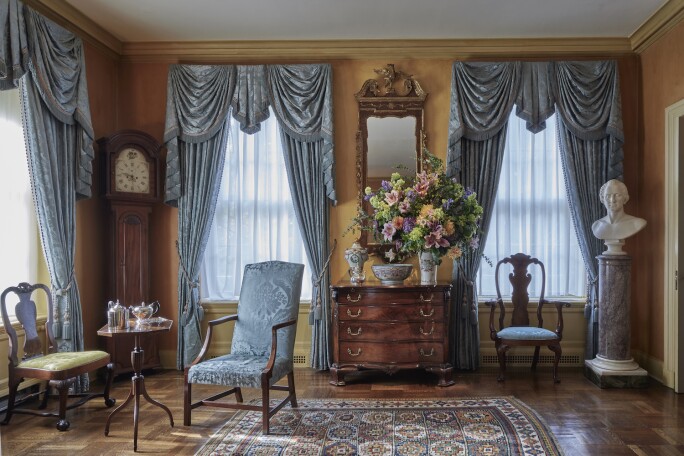E rving and Joyce Wolf lived the American Dream to the fullest. He was a young man from Cheyenne, Wyoming, and she was a girl from Brooklyn, New York, when they met in Denver, the summer of 1951. Seventeen days later – after she proposed – they were married. Over the next 66 years, they assembled a collection that celebrates American art, design and craftsmanship from the 18th to the 20th century. When Sotheby’s offers The Wolf Family Collection: The Spirit of America this spring, it will be the most important auction of its kind to date.

Spanning painting, sculpture and decorative arts, this is a sale filled with “legendary treasures”, says Jodi Pollack, chairman and co-worldwide head of 20th-century design, and is estimated to realise in excess of $40 million. It ranges from the greatest examples of colonial furniture and bronzes by Paul Manship, to art nouveau silver by the Gorham Manufacturing Company, paintings by Winslow Homer and jewelry by Van Cleef & Arpels.
Brief as their courtship was, the Wolfs’ partnership was enduring. After a quick trip to Brooklyn for their wedding, they returned the following day to Cheyenne, where their three children were born. Erving – who had served as an officer in the Navy while stationed in Guam during the Second World War, then earned a law degree from Northwestern University – set his sights on the oil and gas industry. His discoveries (including Wyoming’s 200-million-barrel Hilight Oil Field and its four-trillion cubic-foot Madden Gas Field) became the stuff of legend.
Meanwhile, Joyce put her boots on. She was instrumental in building and overseeing the couple’s vast cattle ranch in Ridgway, Colorado, where the family continued to spend summers after they relocated to New York City.

As they began their life together in the American West, the couple’s collecting journey began close to home. They acquired rugs, pottery and jewelry from trading posts in the Four Corners region, the rugged meeting point between Colorado, Utah, Arizona and New Mexico, and home to Navajo, Ute, Hopi and Zuni tribal nations. Propelled by curiosity, the Wolfs later broadened their scope to include every aspect of American art and design. With their three children often in tow, the family became fixtures in Sotheby’s salerooms. Nearly every weekend, they could be found scouring New York’s 26th Street Flea Market for hidden gems.
“My parents both had incredible collecting genes. When they saw something of beauty, they respected it and often purchased it,” their son Mathew explains. “They didn’t have to look to other countries, because they saw the exquisite things that Americans produced. Their collection encompasses the history and talent of America.”
“They saw the exquisite things that Americans produced. Their collection encompasses the history and talent of America.”
The Wolf Family Collection will be offered in a series of landmark single-owner live and online sales at Sotheby’s New York. These start with an evening sale on 19 April, The Spirit of America, showcasing a selection of the Collection’s masterworks in fine art, sculpture, furniture, Chinese export porcelain, silver and 20th-century design.
The paintings acquired by the Wolfs are exceptional. There are quintessential works by the preeminent portraitists of federal America such as Gilbert Stuart; majestic landscapes by Hudson River School artists Worthington Whittredge and Sanford Robinson Gifford; impressionistic pictures by artists who drew on far-reaching subjects, such as Winslow Homer and John La Farge; and protean examples of American Modernism by Charles Demuth and Maurice B Prendergast. The centrepiece of this treasure trove is In the Studio, executed in 1892 by Impressionist William Merritt Chase. It depicts the artist’s wife in his summer studio on Long Island. Showing a sumptuous tapestry and items of silver and bronze, the richly decorated space that he depicts highlights the artist’s success by this point in his career.

Erving and Joyce Wolf also gathered furniture by the finest makers of their time, including the Gibbs Family Chippendale Block-and-Shell Carved Mahogany Kneehole Bureau Table, circa 1770. Expertly carved in Newport, Rhode Island, it is one of the very best examples of its form. Descended through five generations of the Gibbs family, the piece has only ever been offered at auction once before, when it was last sold at Sotheby’s 40 years ago.
In the earliest years of the American art and design market, the Wolfs had the vision and foresight to acquire some of the most defining and historically important works ever created by artist Louis Comfort Tiffany, plus architects Frank Lloyd Wright and Greene and Greene, who were heavily influenced by the Arts and Crafts movement. Among the showstoppers here is a monumental hanging lantern, crafted with iridised and opalescent glass, mahogany, ebony, abalone, copper, fruitwood and silver inlays, designed by Greene and Greene for their masterpiece, the Robert R. Blacker House in Pasadena, circa 1908. It took pride of place in the house and is one of the most complex pieces of lighting the architects ever created. Its mahogany frame recalls the Japanese-inspired architecture of the rest of the house, while the iridised glass shade features delicately rendered images of vines and birds in flight against a sunset.
Spanning more than 1,000 lots, this deeply personal collection articulates a unique narrative of American history. It’s a real love story, too.
Cover image: Chinese exports “Tiger and Fox Hunt” punch bowl, circa 1775, and a pair of “Landscape” urns and covers, circa 1780, on a Chippendale Serpentine chest of drawers, circa 1790, on display in the Wolfs’ home


